Introduction: An Antwerp Master Emerges
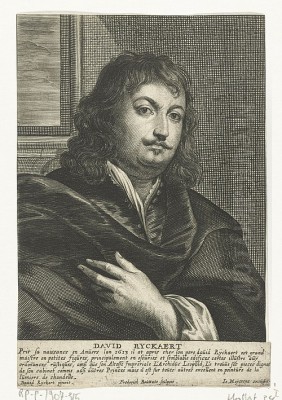
David Ryckaert III (1612–1661) stands as a significant figure in the rich tapestry of Flemish Baroque painting. Born, living, and working primarily in the bustling artistic hub of Antwerp, Ryckaert carved a distinct niche for himself through his vivid and engaging genre scenes. He specialized in depicting the everyday lives of ordinary people – peasants, artisans, musicians, and tavern-goers – offering a window into the social fabric of the Southern Netherlands during the 17th century. While perhaps living under the shadow of Antwerp giants like Peter Paul Rubens and Anthony van Dyck, Ryckaert developed a unique voice, blending keen observation with a lively narrative style that earned him considerable recognition during his lifetime and ensures his relevance today. His work bridges the gap between the boisterous peasant scenes of his predecessors and the more refined depictions of contemporary life, making him a key artist in the evolution of Flemish genre painting.
Artistic Lineage and Early Formation
David Ryckaert III was born into a family deeply rooted in the artistic traditions of Antwerp. His grandfather, David Ryckaert I, was a brewer but also listed as a painter, though no works are known by him. His father, David Ryckaert II (1586–1642), was a respected painter primarily known for still lifes and genre scenes, often featuring rustic interiors or kitchen settings. It was under his father's tutelage that the young David III received his initial artistic training, absorbing the fundamentals of composition, colour, and technique within the family workshop.
Further enriching his artistic environment was his uncle, Maerten Ryckaert (1587–1631), a landscape painter known for his often fantastical, rocky landscapes with small figures, sometimes reflecting an Italianate influence from a likely trip to Italy. Although Maerten specialized in a different genre, his presence within the family network undoubtedly contributed to the young David's broad artistic awareness. This familial immersion in painting provided a strong foundation upon which David Ryckaert III would build his own successful career, inheriting not just skills but also a place within Antwerp's established artistic community.
The Influence of Brouwer and the Early Style
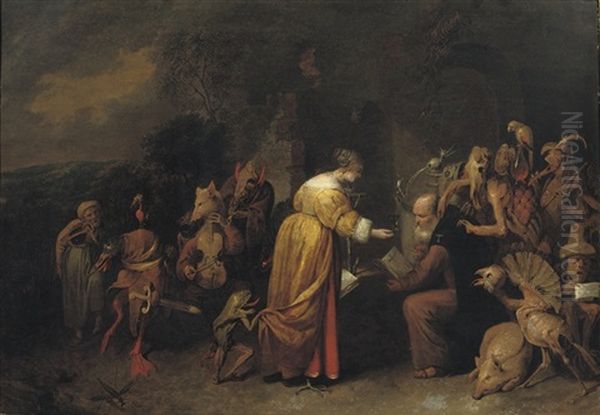
In his formative years, David Ryckaert III's style showed a clear affinity with the work of Adriaen Brouwer (1605/06–1638), a highly influential master of low-life genre scenes who also worked in Antwerp during the 1630s. Brouwer was renowned for his expressive, often rough depictions of peasants carousing, brawling, and smoking in dimly lit taverns and cottages. Ryckaert’s early works echo Brouwer’s thematic concerns and compositional approaches, often featuring small groups of figures engaged in lively, sometimes coarse, activities within rustic interiors.
These early paintings typically employ a more monochromatic palette, dominated by browns and greys, similar to Brouwer's tonal phase. The brushwork can be vigorous and descriptive, capturing the raw energy of peasant life. Works from this period often depict scenes like Peasants Feasting or Tavern Brawls, focusing on the less idealized aspects of rural existence. While influenced by Brouwer, Ryckaert's figures generally possess a slightly less caricatured quality, hinting at the more individualized approach he would later develop. Another contemporary exploring similar themes, though perhaps with a slightly different emphasis, was Joos van Craesbeeck, also considered a follower of Brouwer.
Maturation and the Impact of David Teniers the Younger
As Ryckaert III matured, his style evolved, moving away from the raw intensity of Brouwer towards a more refined and colourful manner. This shift is largely attributed to the pervasive influence of David Teniers the Younger (1610–1690), arguably the most successful and prolific Flemish genre painter of the era. Teniers, who became Ryckaert's brother-in-law through marriage into the Brueghel family (though Ryckaert himself married Jacoba Pallemans), excelled in depicting a wider range of social activities, from peasant kermesses to guardroom scenes, alchemists' laboratories, and elegant companies.
Under Teniers's influence, Ryckaert's palette brightened considerably, incorporating clearer blues, reds, yellows, and greens. His compositions became more complex and spatially coherent, often featuring deeper perspectives and more detailed settings. The figures, while still representing everyday people, became more individualized and less caricatured than in his earliest works. He began to depict not just peasants but also artisans, scholars, and members of the bourgeoisie, broadening his thematic scope. This refinement and diversification allowed Ryckaert to appeal to a wider, more affluent clientele.
Themes of Peasant Life and Merry Companies
Throughout his career, the depiction of peasant life remained a central theme for David Ryckaert III. He captured various facets of rural existence, from moments of leisure and celebration to scenes of labour and domesticity. His "merry company" scenes often show peasants eating, drinking, smoking, and playing music in taverns or cottage interiors. These works, while sometimes depicting boisterous behaviour, generally lack the overt moral condemnation found in some earlier traditions, instead presenting a lively, albeit sometimes chaotic, view of communal life.
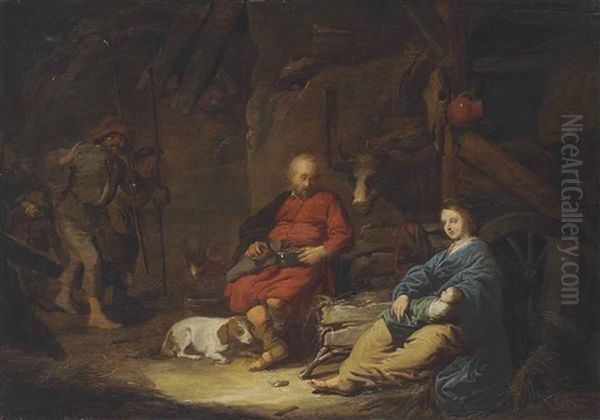
Works like Peasant Interior with an Old Woman or Village Feast exemplify his interest in these themes. He paid close attention to the details of clothing, furniture, and household objects, grounding his scenes in a tangible reality. Music often plays a key role, with figures playing bagpipes, hurdy-gurdies, or violins, adding an auditory dimension to the visual narrative. These depictions catered to an urban audience fascinated by rural life, offering glimpses into a world perceived as both simpler and more robust. His approach often balanced the rustic charm with a degree of order and clarity influenced by Teniers.
Artisans, Professionals, and the World of Work
Beyond the peasantry, Ryckaert III demonstrated a keen interest in depicting artisans and professionals at work, reflecting the diverse urban economy of Antwerp. Shoemakers, coopers, surgeons, dentists, scholars, and, notably, alchemists frequently appear in his oeuvre. These paintings often take place in detailed workshop or study settings, filled with the tools and paraphernalia associated with each trade or profession.
His depictions of shoemakers, for instance, show them diligently working amidst leather scraps and tools, often with family members present, highlighting the integration of work and domestic life. The Alchemist (several versions exist) was a particularly popular theme in 17th-century Flemish art, often carrying moralizing undertones about the folly of pursuing unobtainable wealth or neglecting true knowledge. Ryckaert’s alchemists are typically shown in cluttered laboratories, surrounded by furnaces, alembics, and books, sometimes accompanied by assistants or family members. These works showcase his skill in rendering textures – metal, glass, earthenware, paper – and creating atmospheric interiors through the play of light and shadow.
Musical Scenes and Conviviality
Music-making is a recurring motif in Ryckaert III's work, appearing in both peasant scenes and more refined interior settings. He depicted solitary musicians, small ensembles, and figures enjoying music as part of a larger gathering. These scenes often convey themes of harmony, leisure, and social interaction. The instruments depicted are varied, ranging from the rustic bagpipes and fiddles of peasant gatherings to the more sophisticated lutes and violins found in bourgeois interiors.
A work like Invitation to a Duet captures the charm and intimacy of shared musical experience. His attention to the accurate rendering of instruments and the postures of the players adds to the realism of these scenes. Music in 17th-century genre painting could carry various symbolic meanings, sometimes associated with harmony and order, other times with fleeting pleasure or even vanity. Ryckaert generally seems to focus on the convivial and enjoyable aspects of music, using it to animate his compositions and engage the viewer.
Religious and Fantastical Subjects
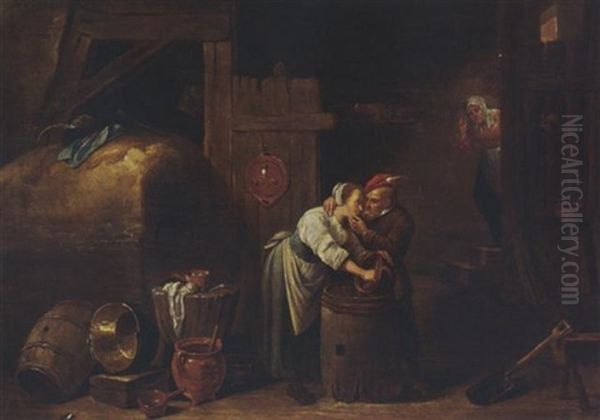
While primarily known as a genre painter, David Ryckaert III also tackled religious and fantastical themes, often infusing them with a genre-like sensibility. He painted several versions of The Adoration of the Shepherds, treating the biblical event with the same attention to rustic detail and human interaction found in his peasant scenes. The shepherds are depicted as contemporary Flemish peasants, making the sacred story relatable to his audience.
More dramatic and imaginative are his depictions of The Temptation of Saint Anthony. This theme, popular since the time of Hieronymus Bosch and revisited by artists like Jan Brueghel the Elder and David Teniers the Younger, allowed painters to explore the realms of the grotesque and the fantastic. Ryckaert’s versions typically show the saint beset by an array of demonic creatures and seductive figures in a wild landscape or cave setting. He also painted scenes related to witchcraft, such as Witches' Sabbath, tapping into contemporary folklore and anxieties. These works showcase his imaginative powers and his ability to handle complex, multi-figured compositions with dramatic lighting.
Technique, Color, and Composition
David Ryckaert III's technique evolved throughout his career but consistently demonstrated a high level of craftsmanship. His application of paint became smoother and more refined in his mature period, allowing for greater detail and subtlety in rendering textures and surfaces. He possessed a strong sense of colour, moving from the more subdued palette of his early years to the brighter, more varied hues influenced by Teniers. His use of light is often skillful, employed to highlight key figures or objects, create atmosphere, and enhance the sense of depth within his interiors and landscapes.
His compositions are typically well-structured, often using diagonal lines or architectural elements to lead the viewer's eye into the scene. He adeptly managed groups of figures, arranging them in dynamic yet coherent ways that facilitate narrative clarity. Whether depicting a crowded tavern or a quiet workshop, Ryckaert paid careful attention to the arrangement of objects and figures to create a believable and engaging space. Works like The Painter's Studio (Louvre) offer insight into the artist's environment and demonstrate his ability to construct complex interior views.
Professional Life: The Guild and Patronage
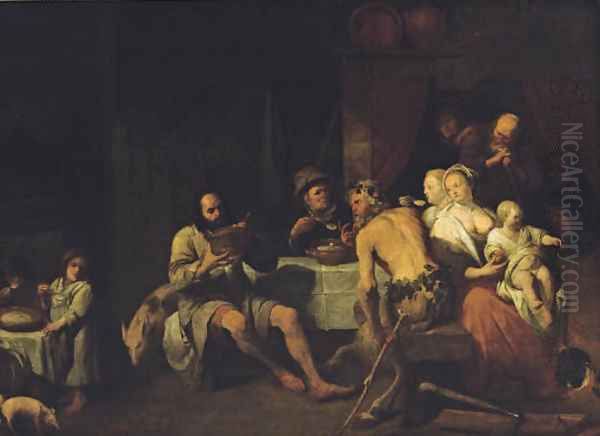
David Ryckaert III achieved considerable professional success in Antwerp. He became a master in the city's prestigious Guild of Saint Luke in 1636–37, the institution that regulated the art trade and upheld standards of training and practice. His standing within the artistic community was further confirmed when he was elected dean of the Guild in 1650–51, a position of significant responsibility and honour. This role placed him at the heart of Antwerp's artistic administration, alongside other prominent figures.
In 1647, Ryckaert married Jacoba Pallemans. While the painter Gonzales Coques (known for his elegant group portraits) was a witness at the wedding and a prominent colleague in the Guild, he was not Ryckaert's father-in-law as sometimes mistakenly suggested. Ryckaert's success attracted patronage from notable collectors. While specific high-level commissions are debated, his works were certainly acquired by discerning buyers. He likely benefited from the patronage network surrounding Archduke Leopold Wilhelm of Austria, Governor of the Spanish Netherlands from 1647 to 1656, who was a voracious collector of Flemish art, particularly favouring David Teniers the Younger. Ryckaert's refined later style would have appealed to such elite tastes.
Contemporaries in the Antwerp Art World
David Ryckaert III worked during a period when Antwerp, despite political and economic challenges, remained a vibrant centre of artistic production. He was contemporary with some of the towering figures of the Flemish Baroque, although his focus on genre differed from their primary output. Peter Paul Rubens (d. 1640) and Jacob Jordaens (d. 1678) dominated the market for large-scale history painting and altarpieces. Anthony van Dyck (d. 1641), though largely based in England later in his career, set the standard for portraiture.
Within the realm of genre and related specialities, Ryckaert's direct contemporaries and influences included Adriaen Brouwer, David Teniers the Younger, and Joos van Craesbeeck. Other notable Antwerp artists active during his lifetime included Frans Snyders (d. 1657), the pre-eminent painter of animals and large still lifes; Jan Brueghel the Younger (d. 1678), who continued his father's tradition of flower painting and landscapes; Theodoor Rombouts (d. 1637), known for his Caravaggesque genre scenes; Cornelis de Vos (d. 1651), a leading portraitist; and Erasmus Quellinus II (d. 1678), a history painter who often collaborated with floral and landscape specialists. This rich milieu provided both competition and inspiration for Ryckaert.
Legacy and Influence
David Ryckaert III died relatively young in Antwerp in 1661, at the age of 49. He left behind a substantial body of work that documents and interprets the life of his time with warmth and skill. His paintings were popular during his lifetime and continued to be collected across Europe. Many found their way into prominent collections, and major museums today, including the Louvre in Paris, the Prado in Madrid, the Rijksmuseum in Amsterdam, the Kunsthistorisches Museum in Vienna, and the Hermitage in St. Petersburg, hold examples of his work.
While he did not establish a large workshop with numerous followers in the manner of Rubens, he did have some impact on subsequent genre painters. His known pupils include Pieter Bredael, who himself became a painter of landscapes and genre scenes. Ryckaert's primary legacy lies in his contribution to the development of Flemish genre painting, particularly his ability to blend the robust earthiness of the Brouwer tradition with the refined technique and broader subject matter associated with Teniers the Younger. He created a distinct artistic personality, offering engaging and detailed portrayals of 17th-century Flemish society.
Conclusion: A Valued Flemish Master
David Ryckaert III remains a highly regarded figure within the Flemish Baroque tradition. As an art historian, one appreciates his skillful synthesis of influences, his technical proficiency, and his insightful depictions of everyday life. His journey from the Brouwer-influenced early works to the more polished and colourful style of his maturity reflects both his personal development and the broader trends in Antwerp painting. His diverse subject matter – encompassing peasants, artisans, musicians, alchemists, and even religious and fantastical themes – provides a rich panorama of 17th-century Flemish culture. Through his detailed observation, lively compositions, and sympathetic portrayal of his subjects, David Ryckaert III secured his place as a master chronicler of his time, whose works continue to engage and inform viewers centuries later. His paintings stand as testaments to the enduring appeal of genre scenes and the vibrant artistic life of Baroque Antwerp.